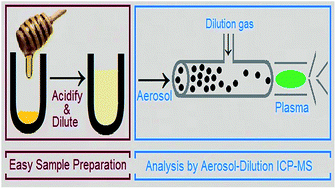Exploiting aerosol dilution for the determination of ultra-trace elements in honey by collision/reaction cell inductively coupled plasma mass spectrometry (CRC-ICP-MS) without thermal digestion
Abstract
A rapid dilute-and-shoot procedure was described for the ultra-trace determination of Li, Al, Cr, Mn, Co, Ni, Cu, Zn, As, Cd, Tl, Pb and U in honey by collision/reaction cell inductively coupled plasma mass spectrometry (CRC-ICP-MS). The aerosol dilution technique was found effective in obtaining a better tolerance to the sample matrix, allowing the use of aqueous standards in the analysis. Some instrumental parameters such as the collision gas flow rate, aerosol dilution rate and sampling depth were optimized for reliable determination of elements in the presence of chloride, especially for Cr and As which are severely affected by carbon and chloride-based polyatomic interferents. The limit of detection (0.01–2.9 ng g−1) and precision (<3.3%) values were excellent. The main advantages of the method are the elimination of thermal digestion and aqueous dilution steps in sample preparation, and considerable reduction in reagent consumption and environmental waste. The results showed the applicability of the method in routine single-run multi-element analysis of various honey types (chestnut, multi-floral and sun flower).



 Please wait while we load your content...
Please wait while we load your content...